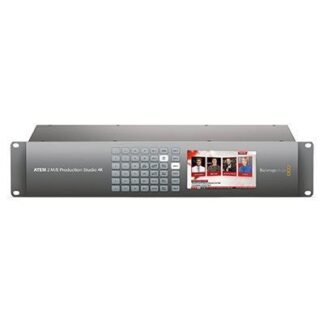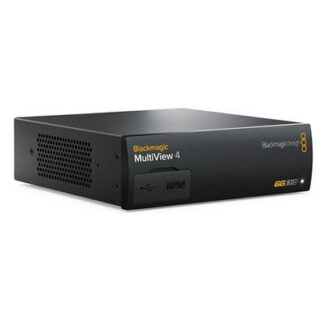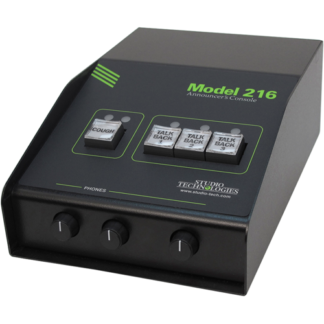Description
he Model 216 is compatible with the latest broadcast and audio system environments that use the Dante technology. An Ethernet connection with Power-over-Ethernet (PoE) power is all that’s required to make the unit part of a sophisticated, networked audio system. Connect a microphone and pair of headphones (or a broadcast headset) and the installation is complete. Whether it’s the on-air audio, the talkback audio, or the headphone cue feed, superior audio quality is always maintained. A range of configuration choices allow the desired operating parameters to be easily selected. These choices can be made locally using pushbutton switches or remotely using the STcontroller application. And while flexible to configure, the user is presented with an easy-to-understand set of controls and indicators.
User Controls and Status Indicators
Four pushbutton switches, five LED indicators, and three rotary controls provide the user with a clear, easy-to-use interface. One pushbutton switch controls the status of the main output. This is the audio channel intended for on-air, announcement, or other primary uses. Two LEDs display the on/off status of the main output. Three additional pushbutton switches control the status of the talkback output channels. These are the audio signals used to communicate with producers, directors, spotters, or other behind-the-scenes production personnel. A status LED is associated with each of the talkback pushbuttons. The pushbutton switches use gold-plated contacts for reliable long-term operation and include backlighting using white LEDs. Three rotary controls allow the user to adjust the content and level of the headphone output.
Microphone Input
The Model 216 provides a high-performance microphone preamplifier which offers low-noise, low-distortion, and high headroom amplification over a 19 to 64 dB range. The gain is adjustable in 3-dB steps. A 2-digit display indicates the amplification in dB. The microphone input is compatible with balanced dynamic or condenser microphones. Phantom power is provided and meets the worldwide P48 standard. A dual-color LED indicator serves as an aid for optimizing the setting of the preamplifier’s gain. Microphone signals are connected to the Model 216 by way of a standard 3-pin female XLR connector.
Output Channels and their Operation
By way of the Dante interface, the Model 216 provides a main output channel and three talkback output channels. The main output channel is designed to serve as the on-air, stadium announcement, or other primary audio feed. The talkback output channels are intended to provide production trucks, control rooms, or support personnel with talent-originated cue signals.
A large part of the Model 216’s unique power is the ability to configure the operation of the main and talkback functions. To meet the needs of the many specific broadcast and production applications, a variety of pushbutton operating modes are available. The main pushbutton can be selected to operate from among four modes. In the “push-to-mute” mode the pushbutton performs a momentary mute of the audio signal associated with the main output channel. In this way a “cough” pushbutton function is created, something typically required for television sports broadcasting. In the “push-to-talk” mode the pushbutton provides a momentary active function for the main output. This mode would be appropriate for an application such as stadium announcement. An alternate action “latching” configuration allows the pushbutton to enable or disable the audio signal associated with the main output channel as desired. This is useful in radio broadcasting, announce-booth, or voice-over applications. The fourth mode provides a hybrid function, supporting both push-to-talk and tap-to-enable/tap-to-disable operation. This operation is similar to that found in many broadcast intercom system user stations.
The three pushbutton switches associated with the talkback functions can be configured to operate from either of two modes. One of the modes supports a “push-to-talk” function. This is typically used for on-air broadcast applications. The other mode provides a hybrid function, the operation of which is discussed in the previous paragraph. The hybrid mode is especially useful when the Model 216 is used in a production-support application.
Overall Model 216 operation can be configured from among one on-air and four production modes. The Model 216’s on-air mode is appropriate for on-air television, radio, and streaming broadcast applications. When on-air is selected the audio signal associated with the main output channel will always mute when one or more of the talkback functions are active. This prevents audio that’s intended for production or support personnel from being sent out the on-air audio path.
Headphone Output
The Model 216 provides a number of configuration choices that relate to the headphone output. These choices include the headphone output gain range, which audio sources are utilized, how the rotary level controls function, and what sidetone action will take place. Four headphone control source assignment modes are offered. These modes impact how the three rotary controls adjust the four Dante input channels and the sidetone audio signals.






